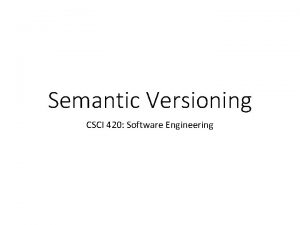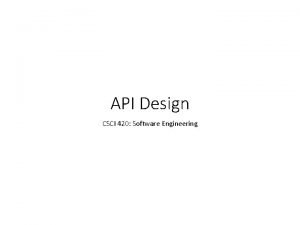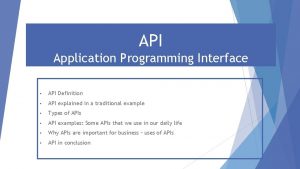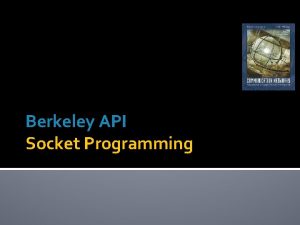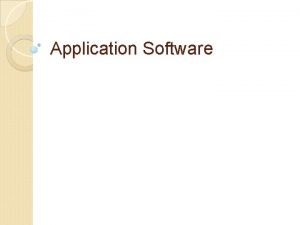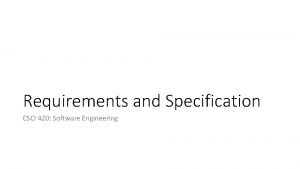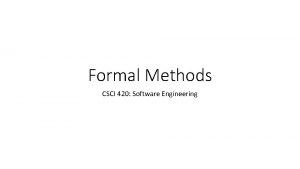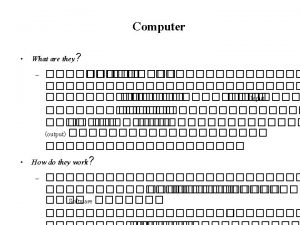API Design CSCI 420 Software Engineering API Application





















- Slides: 21

API Design CSCI 420: Software Engineering

API • Application Programming Interface • Source code interface • For library or OS • Provides services to a program • At its base, like a header file • But, more complete

Why is API Design Important? • Company View • Can be asset – big user investment in learning and using • Bad design can be source of long-term support problems • Once used, it’s tough to change • Especially if there are several users • Public APIs – One chance to get it right

Characteristics of Good APIs • Easy to learn • Easy to use even without documentation • Hard to misuse • Easy to read and maintain code that uses it • Sufficiently powerful to satisfy requirements • Easy to extend • Appropriate to audience

Designing an API • Gather requirements • Don’t gather solutions • Extract true requirements • Collect specific scenarios where it will be used • Create short specification • Consult with users to see whether it works • Flesh it out over time • Hints: • Write plugins/use examples before fully designed and implemented • Expect it to evolve

Broad Issues to Consider in Design 1. Interface • The classes, methods, parameters, names 2. Resource Management • How is memory, other resources dealt with 3. Error Handling • What errors are caught and what is done • Information Hiding • How much detail is exposed • Impacts all three of the above

1. Interface Principles • Simple • General • Regular • Predictable • Robust • Adaptable

Simple • Users must understand! • Do one thing and do it well • Functionality should be easy to explain • As small as possible, but never smaller • Conceptual weight more important than providing all functionality • Avoid long parameter lists • Choose small set of orthogonal primitives • Don’t provide 3 ways to do the same thing

General • Implementation can change, API can’t • Hide Information! • Don’t let implementation detail leak into API • Minimize accessibility (e. g. private classes and members) • Implementation details can confuse users • Be aware of what is implementation • Don’t overspecify behavior of modules • Tuning parameters are suspect

Regular • Do the same thing the same way everywhere • Related things should be achieved by related means • Consistent parameter ordering, required inputs • Functionality (return types, errors, resource management) • Names matter • Self explanatory • Consistent across API • Same word means same thing in API • Same naming style used • Consistent with related interfaces outside the API

Predictable • Don’t violate the principle of Least Astonishment • User should not be surprised by behavior • Even if this costs performance • Don’t reach behind the user’s back • Accessing and modifying global variables • Secret files or information written • Be careful about static variables

Predictable • Try to minimize use of other interfaces • Make as self-contained as possible • Be explicit about external services required • Document! • Every class, method, interface, constructor, parameter, exception • When states are kept, this should be very clearly documented

Robust • Able to deal with unexpected input • Error Handling (see later)

Adaptable • API can be extended, but never shortened • Heavily used APIs likely will be extended • Information Hiding • Implementation details should not affect API

2. Resource Management • Determine which side is responsible for • • Initialization Maintaining state Sharing and copying Cleaning up • Various resources • Memory • Files • Global variables

Resource Management • Generally, free resources where they were allocated • Return references or copies? • Can have huge performance and ease of use impact • Multi-threaded code makes this especially critical • Reentrant: works regardless of number of simultaneous executions • Avoid using anything (globals, static locals, other modifications) that others could also use • Locks can be important

3. Error Handling • Catch errors, don’t ignore them • “Print message and fail” is not always good • Especially in APIs • Need to allow programs to recover or save data • Detect at low level, but handle at high level • Generally, error should be handled by calling routine • The callee can leave things in a “nice” state for recovery, though • Keep things usable in case the caller can recover

Fail Fast • Report as soon as an error occurs • Sometimes even at compile time! • Use of static types, generics

Error Management • Return values • Should be in form the calling function can use • Return as much useful information as possible • Sentinel values only work if function cannot return all possible values of that type • Define pairs, or return another parameter to indicate errors • Use error “wrapper function” if needed • Consistent way of marking, reporting error status • Encourages use • But, can add complexity

Exceptions • Generally indicate a programming error • Programming construct • Set exception value (e. g. as return) • Other program operation when exception thrown • Exceptions usually in global registry • Include information about failure • For repair and debugging • Exceptions should generally be unchecked • Automatically process globally, rather than require explicit checks over and over

Exceptions • Only use in truly exceptional situations • Never use as a control structure • The modern GOTO • Never use exceptions for expected return values • e. g. Invalid file name passed to library is “common”, not an exception
 Csci 420
Csci 420 420 software
420 software Real time software design in software engineering
Real time software design in software engineering Software design fundamentals in software engineering
Software design fundamentals in software engineering Rad software development tools
Rad software development tools Computer based system engineering in software engineering
Computer based system engineering in software engineering Forward engineering in software engineering
Forward engineering in software engineering Chapter 3 skills and applications
Chapter 3 skills and applications Is an os system software or application software
Is an os system software or application software Software maintenance in software engineering ppt
Software maintenance in software engineering ppt Frank maurer
Frank maurer What is software metrics in software engineering
What is software metrics in software engineering Types of software crisis
Types of software crisis Software metrics example
Software metrics example User interface in software engineering
User interface in software engineering What is a design pattern in software engineering
What is a design pattern in software engineering Gui design in software engineering
Gui design in software engineering Function oriented design in software engineering
Function oriented design in software engineering Design concepts in software engineering
Design concepts in software engineering Architectural design in software engineering
Architectural design in software engineering Design principles in software engineering
Design principles in software engineering Detailed design in software engineering
Detailed design in software engineering
